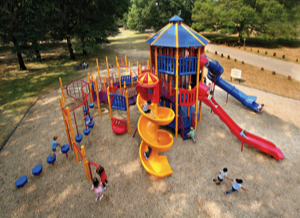

 Adult supervision is key to watching children on some playgrounds; on others it depends upon the age of the child. Will you be buying a metal, plastic or wooden playground? Since equipment cannot supervise children, it is important that adult supervision is present when the playground is being utilized if it’s the style that requires such monitoring. And what about maintenance? Do you have the skills necessary to handle repairs that all playgrounds eventually need? Don’t forget about slips and falls and having a safe place to land on the playground. And ultimately, what does your budget allow you to spend? Are you in the market for a small playground or a larger, more luxurious space to play?
Adult supervision is key to watching children on some playgrounds; on others it depends upon the age of the child. Will you be buying a metal, plastic or wooden playground? Since equipment cannot supervise children, it is important that adult supervision is present when the playground is being utilized if it’s the style that requires such monitoring. And what about maintenance? Do you have the skills necessary to handle repairs that all playgrounds eventually need? Don’t forget about slips and falls and having a safe place to land on the playground. And ultimately, what does your budget allow you to spend? Are you in the market for a small playground or a larger, more luxurious space to play?
- Ask if this particular playground needs to be supervised by adults. Large crawl spaces, boxed-in seating areas, tunnels or other blind spots where children are likely to play for any length of time should be made of Plexiglas or other transparent material so that adults may keep a watchful eye on kids. Ensuring that children do not wear helmets while on playgrounds, for example, is highly important to their safety because the helmet can snag and the strap can asphyxiate children. Many children ride their bicycles, drop their bike and run and jump on the playground without thinking to remove their helmets. That’s why adult supervision, if this is a complicated type of playground equipment you’re seeking, can be key to a safe playground experience.
- Not only is keeping a watchful eye on children as they play important, but being able to properly clean and maintain the playground equipment is also an important question to ask before purchasing a playground. For large groups like schools and parks, will you have the proper staff on hand to preserve the proper function of the equipment? Broken equipment is just an accident waiting to happen. Missing bolts and screws also can create a playground hazard. Therefore, what materials will your playground be made from? Metal, wood or hard plastic? Exposed metal can rust if left untreated. Wood structures can crack as can plastic. That said, it’s important to know what type of playground structure you’re able to properly care for before you decide to buy. What type of material do you want your playground to be?
- Is the playground you’re about to buy age-appropriate? What about two months from now? Playgrounds at parks, for example, generally have play areas for children ages two to five and ages five to 12. Guardrails on platforms help keep children inside the structure where they belong, and age-appropriate signs direct children where to go on the playground without getting hurt. It’s always a good idea to update your playground equipment as needed by adding to it to keep your children engaged and entertained, especially as they grow older.
- It’s also a good idea to offer kids a soft place to land when they fall off their swings and slides. And, it’s a guarantee that they will fall at one time or another. Surfacing materials like rubber crumb are high on the list of cushion materials used by many playgrounds today. Rubber not only cushions impact, but it also reduces slips and falls, thereby enhancing playground safety. Other surfaces may includeat least 12 inches of wood chips, mulch, sand, or pea gravel.
- And ultimately, how much do you want to spend? Depending upon what your budget will allow, playgrounds can run the gamut. But it’s important to remember why playgrounds exist in the first place. They create an environment that encourages learning by providing outdoor curriculum to enhance classroom learning. Playgrounds allow children to exercise their bodies and their minds. You just have to determine how much that is worth.

